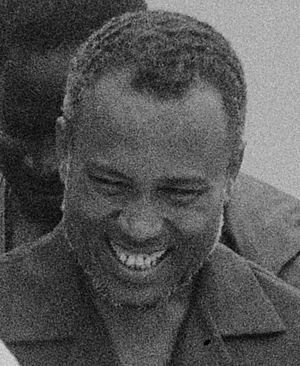Luís Cabral facts for kids
Quick facts for kids
Luís Cabral
|
|
|---|---|

Luís Cabral at the wedding party of Chico Mendes in Ziguinchor, Senegal (1973)
|
|
| 1st President of Guinea-Bissau | |
| In office 24 September 1973 – 14 November 1980 |
|
| Prime Minister | Francisco Mendes |
| Preceded by | Office created |
| Succeeded by | João Bernardo Vieira President of Guinea-Bissau |
| Personal details | |
| Born |
Luís Severino de Almeida Cabral
11 April 1931 Bissau, Portuguese Guinea |
| Died | 30 May 2009 (aged 78) Torres Vedras, Portugal |
| Cause of death | Cardiac Arrest |
| Resting place | Cemitério do Alto de São João |
| Political party | African Party for the Independence of Guinea and Cape Verde |
| Spouse | Lucete Cabral |
Luís Cabral was an important politician from Guinea-Bissau. He was the very first President of Guinea-Bissau, serving from 1974 to 1980. His time as president ended when João Bernardo Vieira led a military takeover. Luís Cabral also helped start a political party called the African Party for the Independence of Guinea and Cape Verde (PAIGC) in 1956, along with his half-brother, Amílcar Cabral.
Contents
Early Life and Education
Luís Cabral was born in Bissau, which was then called Portuguese Guinea, on April 11, 1931. His parents were of mixed race and came from Cape Verde. He went to primary school in the Cape Verde islands, which were also controlled by Portugal back then. Later, he learned about accountancy. He also studied in Bissau and worked for a Portuguese company named Companhia União Fabril.
Fighting for Independence
In 1956, Cabral was one of six people who founded the African Party for the Independence of Guinea and Cape Verde (PAIGC). In the early 1960s, the PAIGC started a guerrilla war against the Portuguese rulers. This was a fight for freedom from colonial rule.
Cabral helped organize a strike by dock workers. This strike was put down very harshly by the Portuguese, and more than 50 people died. This event shocked Cabral and made the PAIGC decide to stop using only peaceful methods.
Luís Cabral became a leader in 1973 after his half-brother, Amílcar Cabral, was killed in Conakry, Guinea. Amílcar was a famous thinker who believed in Pan-Africanism, which is the idea of a united Africa. After Amílcar's death, Aristides Pereira took over the leadership of the PAIGC. Pereira later became the president of Cape Verde. However, the part of the party that focused on Guinea-Bissau followed Luís Cabral.
Becoming President
In April 1974, a big change happened in Portugal called the Carnation Revolution. A new government took power in Portugal and decided to grant independence to its colonies. On September 10, 1974, Portuguese Guinea became independent and was renamed Guinea-Bissau.
The PAIGC had actually declared the country's independence a year earlier, in a village called Madina do Boé. Many socialist and non-aligned countries in the United Nations had already recognized this independence. After Portugal officially recognized it, Luís Cabral became the first President of Guinea-Bissau.
His government started a plan to rebuild and develop the country. They were inspired by Socialism and received help from countries like the USSR, China, and even Nordic countries. Education and healthcare improved a lot in just a few years.
Relations with Portugal were quite good after Guinea-Bissau became independent. President Cabral visited Portugal in 1978. The next year, Portuguese President António Ramalho Eanes visited Guinea-Bissau. They saw their relationship as a good example for Portugal's ties with Angola and Mozambique.
However, some people within the PAIGC felt that Luís Cabral and other members from Cape Verde were too powerful in the party. Because of these feelings, Cabral's Prime Minister, João Bernardo Vieira, led a military takeover on November 14, 1980. Luís Cabral was arrested and held for 13 months.
Life in Exile
After the military takeover in 1980, Luís Cabral was sent away from Guinea-Bissau. He first went to Cuba, which offered him a place to stay. Then, in 1984, he moved to Portugal. The Portuguese government welcomed him and helped him live there with his family until he passed away in 2009.
In December 1998, after the Guinea-Bissau Civil War, Francisco Fadul, who was then the Prime Minister, asked Cabral to return from exile. Cabral said in a Portuguese newspaper that he would be willing to come back, but not while Vieira was still in power. Vieira had said he couldn't guarantee Cabral's safety, so Cabral worried for his life if he returned while Vieira was president.
On October 22, 1999, after Vieira was removed from power, the new leader Ansumane Mane invited Cabral to return. Cabral visited Bissau in mid-November 1999. He stated then that he did not want to get involved in politics again or rejoin the PAIGC.
Death
Luís Cabral died on May 30, 2009, in Torres Vedras, Portugal, at the age of 78. He had been ill for a long time.
The National Assembly of Guinea-Bissau announced: "It is with shock and sadness that the government and people of Guinea-Bissau have learnt of the loss of one of their most illustrious sons, Luis Cabral." They held an emergency meeting and declared three days of national mourning to honor him.
See also
 In Spanish: Luís Cabral para niños
In Spanish: Luís Cabral para niños

